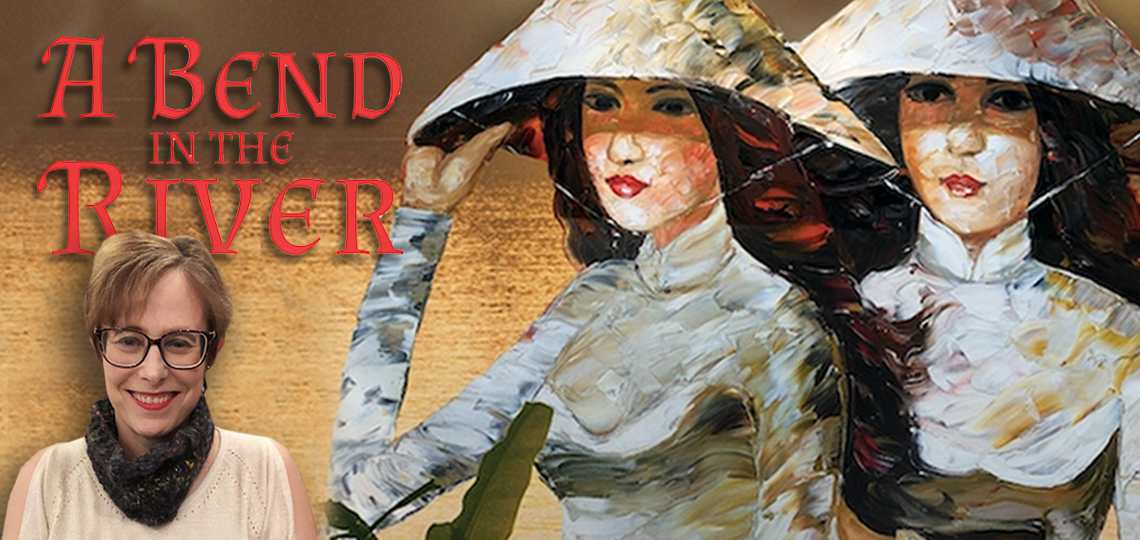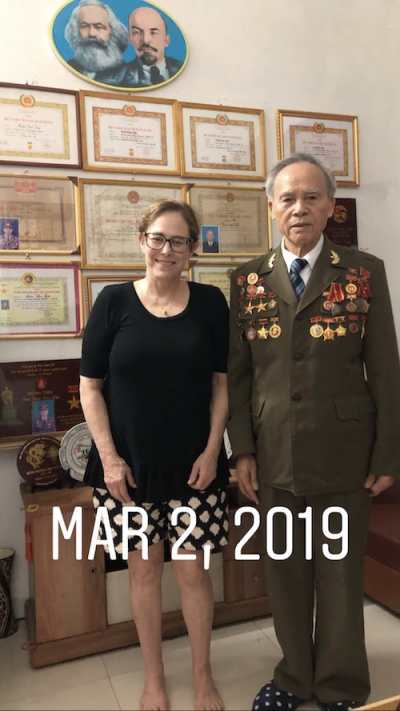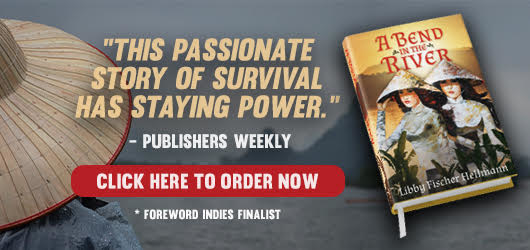Editor-in-Chief Matt Sutherland interviews Libby Hellmann, Author of A Bend in the River

Vietnam, a star-crossed country if there ever was one, but also a fascinating crucible for viewing the last century’s global struggles with colonization, ideology, religious persecution, foreign policy, proxy warfare, and governmental accountability. France, Russia, China, the United States, and other world powers all had competing interests in this sliver of a country on the Indochinese peninsula—with brutal consequences for the Vietnamese people. In many ways these events did shatter their lives into pieces that took generations to heal.
In A Bend in the River, thriller novelist Libby Hellmann trains her accomplished storytelling skills on two young Vietnamese sisters set adrift in the war torn country after their rural village was slaughtered by American GIs in 1968. Told through the eyes of siblings Tâm and Mai, Hellman offers a wholly unique perspective on the American war and the subsequent waves of refugees escaping Vietnam in the war’s aftermath.
Foreword’s Editor-in-Chief Matt Sutherland recently caught up with Hellmann to talk about this extraordinary new coming-of-age novel and why the Vietnam War haunts her still.
You’d be hard-pressed to find a more hellish setting than Vietnam in 1968, but that’s where you chose to set your first non-mystery novel. The revelation in A Bend in the River is that the story is told through the experiences of two young Vietnamese sisters, each with radically different personalities and ideologies. Please talk about your desire to tell this story?
I came of age during the Vietnam War myself and became active against it when I hit college. I knew boys who went, who were killed, and who, when they came back, were different people. I couldn’t understand why Nixon kept us there so long. I remember thinking the bombing of Cambodia was the final straw. But then there was Kent State. And more. Since then, however, age and wisdom have tempered my passion, as they often do, and my attitude towards the war has softened. I wanted to see the country that had taken 50,000 American lives. What made both sides fight to the death? What was so important? That’s why I visited Vietnam in 2019.
I suppose subconsciously I knew I would write about it, but when I arrived I had no idea how. We were in a Saigon (I’ll probably never call it Ho Chi Minh City) art gallery when I came across the painting that’s on the cover of the two girls in their non-las, each carrying a book. I was struck immediately with the story—a moment of grace. The novel would be about two sisters coming of age in wartime, and how the war dictated the trajectory of both their lives. I bought the painting.
What was the role of communism in the hearts of the Vietnamese people on both sides of the war. It’s known to be a critical factor in the American decision to go to war in Vietnam, but were the majority of the North Vietnamese committed communists and willing to die for the it?
There are several levels to your question; thus several responses. For the US, of course, communism was the stated reason for entering the war. “The Domino Theory” was official dictum, but gradually we learned that for America this was a proxy war between Russia, China, and America.
Remember that the French colonized Vietnam and did not permanently withdraw until 1953, after a stunning defeat in Dien Bien Phu. On the other side was Ho Chi Minh, a charismatic leader and Communist since the 1920s, when he (ironically) discovered Marxism while living in Paris.
“Uncle Ho” wanted to free Vietnam from foreign colonization and create a Communist Eden. He got his wish—partially. At the 1954 Geneva Peace Talks, the country was divided into North and South. Ho was leader of the North; Ngo Dinh Diem, the South. There was supposed to be a national referendum to reunify the country a year or two later. That didn’t happen. Instead, war broke out between North and South. At that point, Ho didn’t talk about Communism as much as he did reunification, and that became his guiding maxim. Diem, however, became a dictator, rejecting Communism, Buddhism, other religions, and more. He refused to negotiate with Ho at all. It didn’t take long for the US to start sending military aid to the South. A few years later, aid was supplemented with advisors, and eventually soldiers.
Although it was a bitter war on both sides, many South Vietnamese hated Diem and wanted to reunify under Ho. It wasn’t that they loved Communism. They didn’t. But they hated the corruption of the Diem regime, the fact that they couldn’t see their relatives, or move freely. For both sides, it was seen as a civil war, not a fight for or against Communism. (That changed after the US left and the country did unify, but that’s another story). In fact, there are anecdotes about South Vietnamese Communists, also known as the Viet Cong, that had pictures of Diem on their walls, but when the guerillas came out of the jungles at night, turned them over to a picture of Ho. The North Vietnamese people were certainly indoctrinated into Communism. At the same time, they were eager to reunite the country under Ho, whatever system of government prevailed.
That doesn’t mean everyone was jaded. An interesting side-bar: While I was in Hanoi, I interviewed 
a former North Vietnamese colonel, who greeted me in his military jacket, still spotless, pressed and well-fitting. At the top of his wall was a photo of Karl Marx and Vladimir Lenin. To this day, he remains a committed Communist. In fact, many in the North were true believers.
Fighting for the North, Tâm proves to be an ingenious, decorated soldier until she is nearly killed in a tunnel explosion. After she recovers, she is sent undercover to a small village to gather intelligence. In the home where she rents a room, she meets a woman blinded by Napalm and she admits that it was “becoming increasingly difficult for her to determine who was right and who was wrong in this war, and what her part was.” And later she admits to feeling “like a stranger in her own land.” Was this common among Vietnamese soldiers on both sides after so many years of fighting? Is it also true that the American GIs weren’t especially hated by the North Vietnamese, as if they understood that the Americans were conflicted themselves?
Not really. The evolution of mindset was the byproduct of ten years of war. At first, both the North and the South staked out diametrically opposed principles and acted upon them. Viet Cong training camps taught fighting techniques and Communist propaganda. It was critical to kill Americans and South Vietnamese soldiers. Everything depended on that. Because the North had fewer armaments and supplies, the Viet Cong turned to guerilla fighting. It’s also important to understand that both the North and the Viet Cong had an unlimited supply of soldiers. If and when they lost a battle or were the target of American bombs, there was always a glut of new fighters to replace the dead. That’s why the North lost over a million soldiers and two million civilians. I didn’t investigate South Vietnamese army indoctrination, but it was staunchly anti-Communist.
I can’t say that the war years changed North Vietnamese attitudes, as it did Tâm’s. Certainly it gave them confidence that they would inevitably drive the Americans out, and their leaders made sure to tell them how conflicted American soldiers were. But I can also tell you that the Vietnamese love Americans now. Of course there have been two, maybe three generations since the war so there’s been time for feelings to mellow. And Americans spend money while in Vietnam.
I can also say that South Vietnamese refugees who first came to the US harbored serious suspicions toward North Vietnamese refugees or Viet Cong who managed to escape. In fact, most North Vietnamese refugees hid the fact they were from the north. They could have been ostracized, even killed by former South Vietnamese refugees, and I assume some were. That was Tâm’s problem. When she got to the US, she had to lie and hide that she had fought for the Viet Cong and hope that no one recognized her. Which, of course, they ultimately did.
It was the Americans whose attitudes changed the most, especially after Tet in 1968. The supply of drugs, weed, and drinking rose sharply. US soldiers knew they were fighting an unpopular war, and the major goal was simply survival, not defeating the North and Viet Cong. There are stories, by the way, of US officers giving soldiers speed before a battle, and downers afterwards. I don’t know if that’s true. But I do know there was a lot of depression and “why the hell are we here?” going on. Apocalypse Now was closer to the truth than we thought.
It’s not widely known that many women fought for North Vietnam during the American war in Vietnam. Was this simply a matter of the need for more combatants, or are the Vietnamese more progressive on female rights?
Both. It’s estimated that over 11,000 Vietnamese women fought in the war. At first they were volunteers, primarily nurses, or like Tâm, driving trucks and supplies up and down the Ho Chi Minh Trail. But as the war wore on, they became active fighters, especially the Viet Cong. We went to a museum that commemorated the dead from the war, with hundreds of soldiers’ photos pinned to the walls. I was shocked by the number of women.
The Communist government made a point of praising women soldiers in an effort to motivate the men. They would say, “Look at her driving a truck in enemy territory. If she can do it, so can you.” They also approved of women taking non-traditional roles because under Communism everyone was equal, men and women.
It was different in the South. Both North and South Vietnam had been a traditional, conservative society where women were considered second-class citizens. They were often abused by their husbands, and were responsible for farming, raising children, housework, and taking care of the animals. I found an interview with a group of bargirls, which is what Mai ended up doing, and again I was surprised. The women LOVED being bar-girls. For the first time in their lives, they had a choice of what they wanted to do. Whether they flirted with GIs or had affairs with them was their decision. The GIs, moreover, were courteous and polite to the girls, not at all like Vietnamese men. Many young women vowed to never marry a Vietnamese man.
At the start of the novel, Mai behaves like a spoiled brat, and Tam appears the wiser, more thoughtful sister. Part of it could be the three years between them. After Mai makes the decision to have the baby, though, she begins to see she is not the center of the universe. Tâm, on the other hand, seems to lose her footing as events transpire. Was that intentional?
In an important sense, A Bend in the River is a coming-of-age story for both young women, so yes, it was intentional. My fear was that Mai would be so unappealing to readers that they might put down the book before they realized the arc of her character. I hope that didn’t happen, but if it did, I hope readers will pick it up again. Mai’s self-confidence, while tempered by events, served her well during the war. She was determined and persistent, and after her son was born, she understood the depth of love that a mother has for her child. All of which made her a more sympathetic woman, and, in fact, simplified her overriding goal to provide for him.
Tâm, more analytical and careful from the start, foundered when she realized ideology didn’t make a damn bit of difference when it came to life and death. Without that, she grew bereft and vulnerable. While I’m certainly no expert of the consequences of war, I hope the character development was credibile and persuasive. Both women, while flawed, found a way to survive the “hell on earth” that was the Vietnam war.
In 1975, as the Communist North Vietnamese army advances toward Saigon and winning the war, the city’s residents, including Mai and her young son Đêm Nguyệt, become desperate to escape knowing that they will be persecuted. In Mai’s case, for having consorted with American GIs. And later in the novel, Tâm realizes that even in the US, she was in danger of being discovered as a North Vietnamese soldier and subject to retaliation. Can you talk about how this played out amongst the Vietnamese refugees in the US after the war? Did some of the South Vietnamese hostility towards the North Vietnamese and Viet Cong soften over the years?
It took at least twenty years for attitudes to soften, and for some, they never did. The first wave of refugees whose lives had been shattered by the war were embittered and had nothing but hate for the North. As I said before, North Vietnamese refugees or Viet Cong who managed to escape were considered suspect, and most North Vietnamese refugees hid the fact they were from the north.
The second wave of refugees, the Boat People a few years later, were escaping the repressive Communist regime, which turned out to be much harsher than Diem or Thieu’s government. The refugees still were mostly South Vietnamese, but weren’t treated as hospitably as the first wave. Most went to other Southeast Asian countries, like Malaysia and Indonesia, where they sat on ships for months until third party countries accepted them. It’s likely that there were North Vietnamese and certainly Viet Cong among the Boat People. Again, though, they would not have admitted it.
A third wave came throughout the 1980s, some officially sanctioned, some not. Most were fleeing persecution and hardship in Communist Vietnam. Altogether over 1.3 million refugees settled in the US. Many others settled in Australia, Canada, and France. By that time, it was assumed that plenty of North Vietnamese were among the refugees. Today the hard-liners from the South are dying out, so their hostility has waned.
Vietnam was a confusing place coming out of WWII and into the fifties and sixties and you do a stellar job showcasing the various forces at play—religious, political, cultural, and social. Notably, Tâm and Mai were both strongly influenced by their Buddhist beliefs, but they also had Catholic schooling as children, and then Tâm spent time at a Cao Đài temple. Can you talk about how you developed the confidence to write about these issues so authoritatively and the extensive research you must have done in preparation for writing the book?
First, thanks for the kind words. I love researching probably more than writing, so it was fun. I already knew a little about Buddhism, more about Catholicism, and learned as much as I could about Cao Dai, which is a fascinating faith, similar to the Bahai religion. (We have a huge Bahai temple in Wilmette, only about fifteen minutes from my house.) Like most authors, I only use about a tenth of my research in the book itself, which has always seemed a shame to me. Sometimes I’ve created presentations using more of my findings that I present at libraries and other organizations. For example, I have a program on Cuba and another on Iran, based on my research for the thrillers I wrote about their respective revolutions.
Can we ask what’s next for you and your talented pen?
It’s complicated. I wanted to write a novel set during the early 1950’s about the McCarthy period. I read Demagogue, then discovered there was an ex-pat community in Mexico City composed of East and West coast emigres, many Jewish, liberal, and perhaps socialist. Some had been Party members at one time, and they were all riding out McCarthy south of the border. I read a memoir written by the daughter of one such family and was all set to go to Mexico City to explore where they lived. However, my friends and family forbid me to go because of Covid and Mexico City’s crime rate. Plus, the story was heading into noir territory, and I just didn’t have enough self-righteous anger to write it.
So now I’m writing the sixth installment of my Georgia Davis PI series, which starts with a woman dying from a COVID vaccine. Was it just bad luck or did someone tamper with the vaccine?
I also want to write a novella about my late father-in-law who was one of the Richie Boys, a refugee from Germany in 1939, drafted when he came to the US, sent to Canada for training by the OSS, then back to Germany behind enemy lines during WW2. Fascinating stuff.
I’m also interested in writing about Jewish women, particularly in Eastern Europe, who impersonated Aryans and fought against Hitler. An article in the New York Times featured a book written about these forgotten but incredibly courageous women.
And I’m working on a hardcover version of BEND for libraries and bookstores. It should be available in a week or two.
Matt Sutherland



